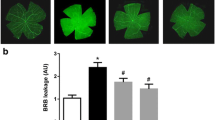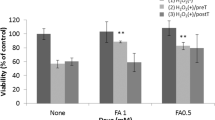Abstract
Objective
To observe the contribution of Borneolum syntheticum to the intervention effect of Liuwei Dihuang Pill (六味地黄丸, LDP) on experimental retinal degeneration, and initially investigate the mechanism of Borneolum syntheticum as meridian-lead-in drug.
Methods
A total of 180 sodium iodateinduced retinital degeneration rats were randomly divided into three groups, including distilled water group, LDP group, and LDP+Borneolum syntheticum (LDP+BS) group. Twenty normal rats were fed regularly without any treatment as normal control. On day 7 and 14 after treatment, histopathological study and transferase-mediated deoxyuridine triphosphate-biotin nick end labeling (TUNEL) test were performed to evaluate the retinopathy. Claudin-5 expression at blood-retina barrier (BRB) was detected by Western blot at different time points from 0.5 to 8 h after gavage.
Results
On day 7 and 14 after treatment, the retinal lesion grades were significantly different among the three groups (P<0.05). The grade in the LDP+BS group was significantly less than the LDP and distilled water groups (both P<0.05), no significant difference was observed between the LDP and distilled water groups (P>0.05). The apoptosis rates in the LDP+BS group was significantly less than the distilled water and LDP groups (both P<0.05), while there was no significant difference between LDP and distilled water groups (P>0.05). Expression of claudin-5 in LDP+BS group was significantly less than the other two groups at 0.5, 1 and 2 h after gavage (P<0.05). There was no apparent difference among the three groups at 4 and 8 h after gavage (P>0.05).
Conclusion
Borneolum syntheticum could strengthen the effect of LDP on experimental retinal degeneration, indicated that Borneolum syntheticum might play the role of meridian-lead-in drug in the formula. The mechanism may be due to Borneolum syntheticum could promote the physiologically openness of bloodretina barrier through transiently affecting the expression of claudin-5.
Similar content being viewed by others
References
Jiang ZH, Zhang J. Discuss on local differentiation and systemic differentiation in TCM ophthalmology. China Pract Med (Chin) 2008;3:91–92.
Jiang P, Fu P, Xiang L, Wang S, Liu X, Yang L, et al. The effectiveness of borneol on pharmacokinetics changes of four ginsenosides in Shexiang Baoxin Pill in vivo. Biomed Chromatogr 2014;28:419–427.
Yang HB, Li ZJ, Yu NN, Jin D, Zhao XM, Cui H. Effect of borneol in improving the permeability of blood-ocular barrier. Int J Ophthalmol (Chin) 2008;8:1576–1578.
Enzmann V, Row BW, Yamauchi Y, Kheirandish L, Gozal D, Kaplan HJ, et al. Behavioral and anatomieal abnormalities in a sodium iodate-induced model of retinal pigment epithelium degeneration. Exp Eye Res 2006;82:441–448.
Liang LN, Wang ZQ, MA Na, Ma QY, Li J, Tang YZ, et al. Contribution of Radix Saposhnikoviae to the intervention effect of Liuwei Dihuang Pills on experimental retinal degeneration. China J Chin Ophthalmol 2013;23:313–317.
Zhu YT, Deng XG, Gao Y, He MF, Li N. Pathological changes and activity of SOD and CAT in the damaged retina induced by sodium iodate in rats. Chin J Pathophysiol (Chin) 2010;26:1851–1854.
Sorsby A. Experimental pigmentary degeneration of the retina by sodium iodate. Br J Ophthalmol 1941;25:58–62.
Kannan R, Hinton DR. Sodium iodate induced retinal degeneration: new insights from an old model. Neural Regen Res 2014;9:2044–2045.
Machaliska A, Lejkowska R, Duchnik M, Kawa M, Rogiska D, Wiszniewska B, et al. Dose-dependent retinal changes following sodium iodate administration: application of spectraldomain optical coherence tomography for monitoring of retinal injury and endogenous regeneration. Curr Eye Res 2014;39:1033–1041.
Carido M, Zhu Y, Postel K, Benkner B, Cimalla P, Karl MO, et al. Characterization of a mouse model with complete RPE loss and its use in RPE cell transplantation. Invest Ophthalmol Vis Sci 2014;55:5431–5444.
Franco LM, Zulliger R, Wolf-Schnurrbusch UE, Katagiri Y, Kaplan HJ, Wolf S, et al. Decreased visual function after patchy loss of retinal pigment epithelium induced by low-dose sodium iodate. Invest Ophthalmol Vis Sci 2009;50:4004–4010.
Guan Y, Cui L, Qu Z, Lu L, Wang F, Wu Y, et al. Subretinal transplantation of rat MSCs and erythropoietin gene modified rat MSCs for protecting and rescuing degenerative retina in rats. Curr Mol Med 2013;13:1419–1431.
Kiuchi K, Yoshizawa K, Shikata N, Moriguchi K, Tsubura A. Morphologic characteristics of retinal degeneration induced by sodium iodate in mice. Curr Eye Res 2002;25:373379.
Wang J, Iacovelli J, Spencer C, Saint-Geniez M. Direct effect of sodium iodate on neurosensory retina. Invest Ophthalmol Vis Sci 2014;55:1941–1952.
Zhao RZ, Liu SJ. TCM medicinal guide theory and target-tropism administration. J Tradit Chin Med (Chin) 2005;46:643–645
Liu N, Gao XC. The study of blood-brain barrier opening by Borneol. Acta Acad Med Weifang (Chin) 2007;29:398–400
Ge CL, Han MF, Bai RT, Yu C. Effect of borneol on the ultrastructure of promoting blood brain barrier Open. Chin J Integr Med Cardio-/Cerebrovasc Dis (Chin) 2008;6:1183–1185.
Campbell M, Nguyen AT, Kiang AS, Tam L, Kenna PF, Dhubhghaill SN, et al. Reversible and size-selective opening of the inner blood-retina barrier: a novel therapeutic strategy. Adv Exp Med Biol 2010;664:301–308.
Campbell M, Humphries MM, Humphries P. Barrier modulation in drug delivery to the retina. Methods Mol Biol 2013;935:371–380.
Campbell M, Nguyen ATH, Kiang AS, Tam LC, Gobbo OL, Kersken C, et al. An experimental platform for systemic drug delivery to the retina. Proc Natl Acad Sci 2009;106:17817–17822.
Author information
Authors and Affiliations
Corresponding author
Rights and permissions
About this article
Cite this article
Liang, Ln., Bai, Yy., Tang, Yz. et al. Contribution of Borneolum syntheticum to the Intervention Effect of Liuwei Dihuang Pill (六味地黄丸) on Experimental Retinal Degeneration. Chin. J. Integr. Med. 24, 442–447 (2018). https://doi.org/10.1007/s11655-016-2584-0
Received:
Published:
Issue Date:
DOI: https://doi.org/10.1007/s11655-016-2584-0




